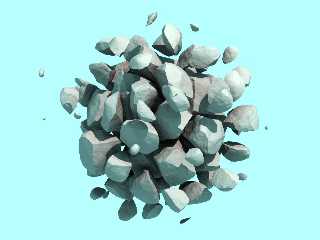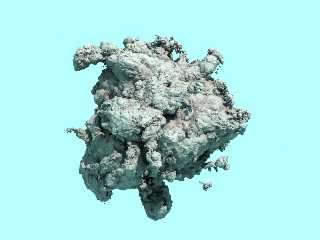 |
 |
|
 |
|
 |
|  |
|  |
|
 |
|
 |
|  |
|  |
|
 |
A couple of isosurface experiments. The first is crackle, the second
granite, both using a pigment function threshold defined by 1-r. Quite nice
to see a finite version of what the patterns actually look like!
Bill
Post a reply to this message
Attachments:
Download 'iso1.jpg' (70 KB)
Preview of image 'iso1.jpg'

|
 |
|  |
|  |
|
 |
|
 |
|  |
|  |
|
 |
And the other
Post a reply to this message
Attachments:
Download 'iso2.jpg' (75 KB)
Preview of image 'iso2.jpg'

|
 |
|  |
|  |
|
 |
|
 |
|  |
|  |
|
 |
I like the first one: it seems a stone explosion (or implosion?)
;-)
Paolo
> "Bill Pragnell" wrote:
> A couple of isosurface experiments. The first is crackle, the second
> granite, both using a pigment function threshold defined by 1-r. Quite
nice
> to see a finite version of what the patterns actually look like!
>
> Bill
Post a reply to this message
|
 |
|  |
|  |
|
 |
|
 |
|  |
|  |
|
 |
Bill Pragnell wrote:
> A couple of isosurface experiments. The first is crackle, the second
> granite, both using a pigment function threshold defined by 1-r. Quite nice
> to see a finite version of what the patterns actually look like!
>
> Bill
>
>
> ------------------------------------------------------------------------
>
Sweet! Whenever I try to do something like that (pat a
function into a rough sphere), I get discontinuities: the
edge of the sphere.
And they render too slow. ;)
--
to all the companies who wait until a large user base becomes
dependant on their freeware, then shafting said happy campers with
mandatory payment for continued usage. I spit on your grave.
Post a reply to this message
|
 |
|  |
|  |
|
 |
|
 |
|  |
|  |
|
 |
> Sweet! Whenever I try to do something like that (pat a
> function into a rough sphere), I get discontinuities: the
> edge of the sphere.
#declare Cracko = function {
pigment { crackle turbulence 0.1
color_map { [0 color rgb 1]
[1 color rgb 0] } } }
isosurface { function { Cracko(x*2,y*2,z*2).gray-(1-(x*x+y*y+z*z)/3) }
max_gradient 5
contained_by { box { -3, 3 } }
pigment { color White }
finish { ambient 0 } }
> And they render too slow. ;)
Oh yes. Especially with radiosity. These each took about an hour and a half
to render on a 1.2GHz iBook. Although perhaps I shouldn't have been playing
music on it at the same time(!).
B
Post a reply to this message
|
 |
|  |
|  |
|
 |
|
 |
|  |
|  |
|
 |
Bill Pragnell nous apporta ses lumieres en ce 2005-10-04 09:48:
>>Sweet! Whenever I try to do something like that (pat a
>>function into a rough sphere), I get discontinuities: the
>>edge of the sphere.
>
>
> #declare Cracko = function {
> pigment { crackle turbulence 0.1
> color_map { [0 color rgb 1]
> [1 color rgb 0] } } }
> isosurface { function { Cracko(x*2,y*2,z*2).gray-(1-(x*x+y*y+z*z)/3) }
> max_gradient 5
> contained_by { box { -3, 3 } }
> pigment { color White }
> finish { ambient 0 } }
>
>
>>And they render too slow. ;)
>
> Oh yes. Especially with radiosity. These each took about an hour and a half
> to render on a 1.2GHz iBook. Although perhaps I shouldn't have been playing
> music on it at the same time(!).
>
> B
>
Instead of using .gray, try .red or .green or .blue or .x or .y or .z. They all return
the same
thing when using a plain black to white pattern and are faster: evaluate a single
colour. .gray
first evaluate each colour and average them. As, in this case, each chanel are
identical, that
operation is futile.
Playing music rarely take more that 5%CPU and not all the time... In my case, it's
more in the 1~2%
range, in bursts.
--
Alain
-------------------------------------------------
Don't cry because it is over, smile because it
happened.
Post a reply to this message
|
 |
|  |
|  |
|
 |
|
 |
|  |
|  |
|
 |
Bill Pragnell wrote:
>>Sweet! Whenever I try to do something like that (pat a
>>function into a rough sphere), I get discontinuities: the
>>edge of the sphere.
>
>
> #declare Cracko = function {
> pigment { crackle turbulence 0.1
> color_map { [0 color rgb 1]
> [1 color rgb 0] } } }
> isosurface { function { Cracko(x*2,y*2,z*2).gray-(1-(x*x+y*y+z*z)/3) }
> max_gradient 5
> contained_by { box { -3, 3 } }
> pigment { color White }
> finish { ambient 0 } }
>
>
>>And they render too slow. ;)
>
> Oh yes. Especially with radiosity. These each took about an hour and a half
> to render on a 1.2GHz iBook. Although perhaps I shouldn't have been playing
> music on it at the same time(!).
>
> B
>
Woa! Thanks for posting that code. That helps a bunch!
--
to all the companies who wait until a large user base becomes
dependant on their freeware, then shafting said happy campers with
mandatory payment for continued usage. I spit on your grave.
Post a reply to this message
|
 |
|  |
|  |
|
 |
|
 |
|  |




![]()